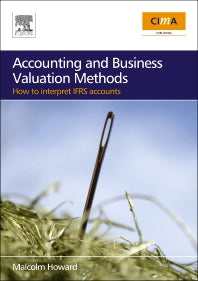Freshly Printed - allow 10 days lead
Couldn't load pickup availability
Accounting and Business Valuation Methods
how to interpret IFRS accounts
A practical quick reference guide for accountants - assess the strength of a companys balance sheet
Malcolm Howard (Author)
9780750684682, Elsevier Science
Paperback, published 14 November 2007
312 pages
23.4 x 15.6 x 2 cm, 0.56 kg
This book is intended to appeal to junior accountants and entrepreneurs who need guidance and practical analytical tools to enable them to develop business plans, raise capital and assess risk. Readers can initiate their own business plans by copying over 200 lines of formulae that create a 5 year plan that includes an earnings statement (or profit and loss account), balance sheet and cash flow statement. It will also appeal to students taking accounting and finance modules that cover basic accounting techniques, ratio analysis, investment appraisal, as well as company valuation and share valuation. The book demonstrates with four case studies where practice often differs with theory.
Chapter 1 covers basic book-keeping, showing how accounts are reconciled and controlled covering topics such as the working capital cycle and negotiating techniques. Chapter 2 deals with basic business planning and how to use ratio analysis (performance, asset management, structure, and investment ratios) to assess company performance. Chapter 3 explains that published accounts are based on a series of judgements and the effect the relatively new international financial reporting standards and legislation such as the Sarbanes-Oxley Act is having on corporate governance. Chapter 4 covers risk assessment and valuing companies. Four case studies bring everything together; how investment trusts are valued, the effect of restructuring on share prices, the difference between serious profit warnings and mere compliance with regulation and hostile takeovers.
Via a thorough analysis of published accounts this book will show readers how to: distinguish between mandatory and optional reports; assess the strength of a company’s balance sheet; assess the risk factors associated with investment; assess whether or not the market value of a particular company is justified.
How accurate are the accounts?
Basic principles of accounting
Accounting standards
Industry standards
The Annual Report
Responsibilities of those signing the Annual Report
Key words and limitations
The principle of judgement
What makes a director act imprudently
Clues to assess accuracy
The basic tools of analysis
Reviewing market valuations and market to book ratio
Assessing the Balance Sheet
Cash is king ? funds generation
Is the company making good use of its assets
Ratio analysis (performance, asset management, structure and investor ratios)
Investment appraisal procedures
Valuing companies
Systematic and unsystematic risk
Portfolio theory and diversification
The Capital Asset Pricing Model
Shortcomings of accepted economic theory
Problems associated with traditional methods of assessment ? horizontal and vertical analysis
The irrationality of stock markets
The human factor
Income v growth
Valuation techniques for manufacturing and service companies
How to calculate the growth built into a share price
How to assess unsystematic risk
Case Studies (each point is illustrated by a particular company)
Understanding the industry
Benefiting from a cautious board
A classic income share
The cost of an imprudent board
Price paid for excessive growth strategies
Biting off more than one can chew
Dramatic effect of stalled growth
Overstated assets
Profits without cash
Why it is usually better to be acquired.
Subject Areas: Accounting [KFC]


